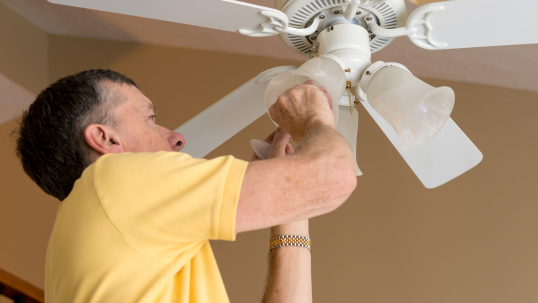Why Ceiling Fans Are Always In Style
Ceiling fans may not be the main focus of a space, but they offer great benefits in terms of both style and function. They can help reduce heating and cooling costs while improving comfort in your Port St. Lucie home. Whether used alone or alongside your heating and cooling systems, ceiling fans are a smart and cost-effective way to save energy throughout the year.
How Do Ceiling Fans Work?
Ceiling fans operate by circulating air in a room, creating a gentle breeze and directing warm or cool air where needed most. While ceiling fans do not cool the air like air conditioning units, they do enhance air circulation.
In addition to the size of the ceiling fan and the shape of its blades, the direction in which it spins also matters according to the seasons.
- Ceiling fans should spin clockwise in winter. Because warm air rises, a clockwise spinning fan will create an updraft, pushing warmer air down along the walls. After you set your ceiling fan direction for winter, set the speed on low to avoid creating a breeze.
- The ceiling fan direction for summer is counterclockwise. This creates a downdraft that produces a cooling breeze throughout the room. The faster the fan spins, the more air it moves, and the more of a breeze you’ll feel.

How Ceiling Fans Pay for Themselves
Despite being invented in 1882, ceiling fans remain one of the most effective cooling methods available to homeowners worldwide—and also one of the simplest. Over time, your new ceiling fan may pay for itself by letting you use your HVAC system less often and for shorter periods.
Ceiling Fan Efficiency
Are you wondering, “Are ceiling fans energy efficient?” Although efficiency varies by model, most ENERGY STAR-rated ceiling fans are more energy efficient than central air conditioning units. They’re also more efficient than portable fans because they move substantially more air by volume.
Modern Ceiling Fan Tech Is Smart
Ceiling fan technology didn’t stop in 1882. Modern ceiling fans have improved motor and blade designs to reduce energy use and move air more efficiently, and many pair with smart home systems like Alexa or Nest. This allows your HVAC and ceiling fan to complement each other and maximize your energy savings and comfort.
How To Size a Ceiling Fan
If you want to install a new ceiling fan, choose the right size. Ceiling fan sizes are based on the blade span, which is the full diameter of the circle made by the blades when they spin. A fan that is too large can create an overwhelming breeze and dominate the room. A fan that is too small will not provide enough airflow.
ENERGY STAR recommends finding the right ceiling fan based on the square footage of the room where it will be installed:
- Rooms up to 100 square feet: 29- to 36-inch fan
- Rooms up to 400 square feet: 36- to 50-inch fan
- Rooms larger than 400 square feet: 50- to 71-inch fan
Read more: Home Energy Efficiency Tips To Save Money
Are Ceiling Fans Worth It?
Absolutely, ceiling fans are worth the investment! A well-maintained ceiling fan allows you to raise your thermostat by 4 or 5 degrees during the summer, contributing to measurable ceiling fan energy savings each year. While slightly less impactful during winter, they distribute heat more evenly to reduce how often and how long your heating system runs.
Our Ceiling Fan Expertise Makes Installation a Breeze
At Elite Electric, Plumbing & Air, we recognize that energy efficiency can significantly affect your family's budget. Our home services are designed to deliver superior performance and provide worry-free use. Whether you need HVAC maintenance or ceiling fan installation, you can rely on quality work from our experienced and friendly technicians in and around Port St. Lucie, FL. We’re here to help, so schedule your appointment today!
Call 772-356-1735 or contact us online to schedule HVAC, electrical, or plumbing services in Port St. Lucie, Jupiter, and the surrounding areas.

